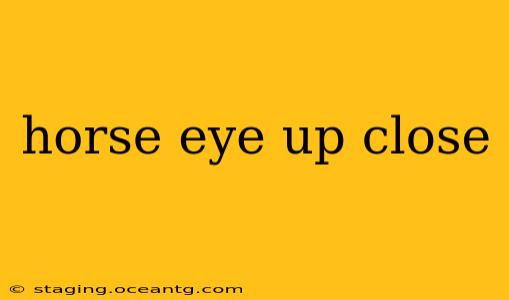The equine eye, up close, reveals a fascinating complexity. More than just a pretty feature, a horse's eye is a remarkable organ adapted for survival in their natural environment. Understanding its structure and function offers insight into their behavior and well-being. This article delves into the intricacies of the horse's eye, exploring its unique characteristics and answering common questions.
What Makes a Horse's Eye Unique?
Compared to human eyes, several key differences set the equine eye apart. Their eyes are proportionally larger, granting a wider field of vision crucial for detecting predators and navigating their surroundings. The placement of their eyes on the sides of their heads provides near-panoramic vision, exceeding 350 degrees, allowing them to see almost everything around them without turning their heads much. This monocular vision, however, results in a smaller area of binocular vision (overlapping vision from both eyes), reducing depth perception compared to humans.
How Do Horses See Color?
What colors can horses see? Horses are dichromats, meaning they possess two types of cone cells in their retinas, enabling them to distinguish between a limited range of colors. While they can see shades of green and blue, they struggle to differentiate reds and oranges clearly. Their vision is more attuned to variations in shades of gray and subtle movements.
What is the Tapetum Lucidum?
What is the reflective layer in a horse's eye? The tapetum lucidum is the iridescent layer located behind the retina. This reflective tissue enhances night vision by reflecting light back through the retina, amplifying the amount of light available for processing. This is why horse's eyes seem to glow in low light conditions. This adaptation is vital for their survival in the wild where they are often active during dawn and dusk.
How Does a Horse's Eye Differ From a Human Eye?
How are horse and human eyes different? Beyond the obvious differences in size and placement, several key distinctions exist. Horses possess a much larger sclera (the white part of the eye) providing greater protection. Their pupils are more oval-shaped, adjusting to light conditions more efficiently than circular pupils. The lens of a horse's eye is less flexible than a human's, limiting their ability to focus on close-up objects.
What are Common Eye Problems in Horses?
What are some common eye problems horses face? Horses, like other animals, are susceptible to various eye ailments. These include:
- Uveitis: Inflammation of the uvea, the middle layer of the eye.
- Cataracts: Clouding of the eye's lens, leading to impaired vision.
- Equine Recurrent Uveitis (ERU): A chronic inflammatory condition affecting the eye.
- Corneal ulcers: Open sores on the surface of the eye.
Regular veterinary check-ups are crucial for early detection and treatment of any eye problems.
Conclusion
The horse's eye, up close, reveals a remarkable adaptation to its environment. Its unique characteristics provide valuable insights into equine behavior, vision, and overall health. Understanding these features enhances our appreciation for these magnificent animals and emphasizes the importance of providing proper care for their delicate eye structures. While we may not fully comprehend the exact nuances of their visual experience, studying their eyes offers a window into the fascinating world of equine perception.
